Hamsters are known for their adorable and curious nature, but do they play with each other? If you’ve ever wondered about the social interactions and playing habits of these tiny creatures, you’ve come to the right place. In this article, we will explore whether hamsters engage in playful activities with their fellow companions, as well as delve into the factors that can affect their interactions.
Key Takeaways:
- Hamsters can play with each other, but it is important to differentiate between play fighting and actual fighting.
- Play fighting is characterized by behaviors such as chasing, squeaking, and dominant and submissive behavior.
- Actual fighting involves biting, cornering, and causing injury.
- Hamsters that play together may engage in activities like grooming and foraging.
- Some hamsters are more territorial and may not be able to live together peacefully.
Now that we have set the stage, let’s dive into the world of hamster social interactions and explore the intricacies of their playful behavior!
Hamster Social Interactions
Hamsters are social creatures, and their interactions with others play a vital role in their happiness. Understanding how hamsters interact can help create a harmonious environment and ensure their well-being.
Play is an essential part of hamster social interactions. When hamsters play, they engage in activities like chasing, squeaking, and displaying dominant and submissive behavior. Play fighting, in particular, is a common behavior among hamsters. It can involve wrestling, chasing, and mock biting. It is important to note that play fighting is typically non-aggressive and serves as a way for hamsters to establish dominance and hierarchy within their group.
Play fighting is characterized by chasing, squeaking, and dominant and submissive behavior, while actual fighting involves biting, cornering, and causing injury.
Hamsters that play together often engage in other activities like sleeping together, grooming each other, and foraging. These interactions help strengthen their social bonds and promote overall well-being. However, it is crucial to monitor their interactions closely, as some hamsters may not get along due to individual personalities or territorial behaviors.
In cases where hamsters display aggressive behaviors like biting, cornering, or causing injuries, it is essential to separate them immediately to prevent harm. Factors like stress, lack of space, and a shortage of enrichment accessories can contribute to fighting among hamsters. Providing ample space, enrichment items, and a peaceful environment can minimize conflicts and promote positive social interactions.
Table 1 – Common Hamster Social Behaviors
| Behavior | Description |
|---|---|
| Play Fighting | Non-aggressive behavior involving chasing, wrestling, and mock biting. |
| Grooming | Hamsters clean each other by licking and nibbling their fur. |
| Sleeping Together | Hamsters may choose to sleep close to each other, promoting a sense of security. |
| Foraging | Hamsters explore their environment together, searching for food and engaging in a shared activity. |
Overall, understanding hamster social interactions and providing a suitable environment can contribute to their happiness and well-being. By promoting positive socialization, monitoring their interactions, and taking necessary precautions, hamsters can enjoy their playtime together, fostering a harmonious and fulfilling life.

When observing hamsters playing with each other, it’s important to recognize the difference between play fighting and actual fighting. Play fighting is a common behavior among hamsters and serves as a way for them to establish dominance, build social bonds, and release energy. It often involves chasing, squeaking, and displays of dominant and submissive behavior.
Play fighting can be characterized by frequent pauses and breaks, as well as body language that indicates a playful intent. Hamsters engaged in play fighting may take turns being the aggressor and the recipient, showing an understanding of the reciprocal nature of the behavior. This type of interaction is usually harmless and serves as a form of enrichment for the hamsters involved.
On the other hand, actual fighting between hamsters is more aggressive and can lead to injuries if not intervened. In an actual fight, hamsters may exhibit behaviors such as biting, cornering, and causing harm to each other. These fights are often not playful in nature and can be a result of territorial disputes or competition for resources.
Actual fighting among hamsters should be taken seriously and steps should be taken to separate them immediately to prevent further harm or injury.
In order to ensure the safety and well-being of hamsters, it is important for owners to closely monitor their interactions and intervene if aggression escalates. Providing ample space, enrichment accessories, and a stress-free environment can help minimize the occurrence of fighting among hamsters. Additionally, understanding the individual personalities and preferences of hamsters can aid in creating a harmonious living environment for them.
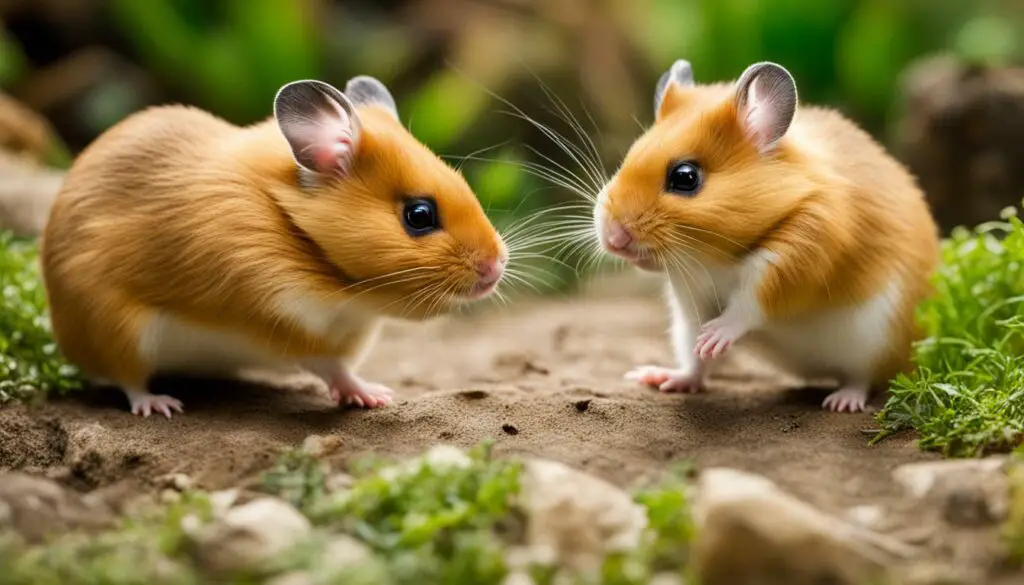
| Play Fighting | Actual Fighting |
|---|---|
| Chasing | Biting |
| Squeaking | Cornering |
| Dominant and submissive behavior | Causing injury |
| Body language indicating playfulness | Aggressive body language |
| Frequent pauses and breaks | Continuous aggression with no breaks |
By understanding the behaviors associated with play fighting and actual fighting, hamster owners can ensure the well-being of their pets and promote positive social interactions. Creating a safe and enriching environment will allow hamsters to engage in appropriate play behaviors and form beneficial social bonds.
Playful Activities Between Hamsters
When hamsters play together, they enjoy engaging in a range of playful activities that strengthen their social bonds. These activities not only provide physical exercise but also stimulate their minds and promote overall well-being.
One common playful activity among hamsters is chasing. They love to run after each other, darting in and out of tunnels, and scurrying around their habitat. This chasing behavior not only allows them to burn off excess energy but also adds an element of excitement and fun to their playtime together.
Grooming is another important activity that hamsters engage in when playing with each other. They take turns licking and cleaning each other’s fur, which not only helps them maintain good hygiene but also strengthens their bond. This grooming behavior is a sign of trust and affection between hamsters.
Foraging is yet another playful activity that hamsters enjoy. They love searching for food hidden in various parts of their habitat. This not only satisfies their natural instinct to forage but also provides mental stimulation. It’s like a treasure hunt for them!
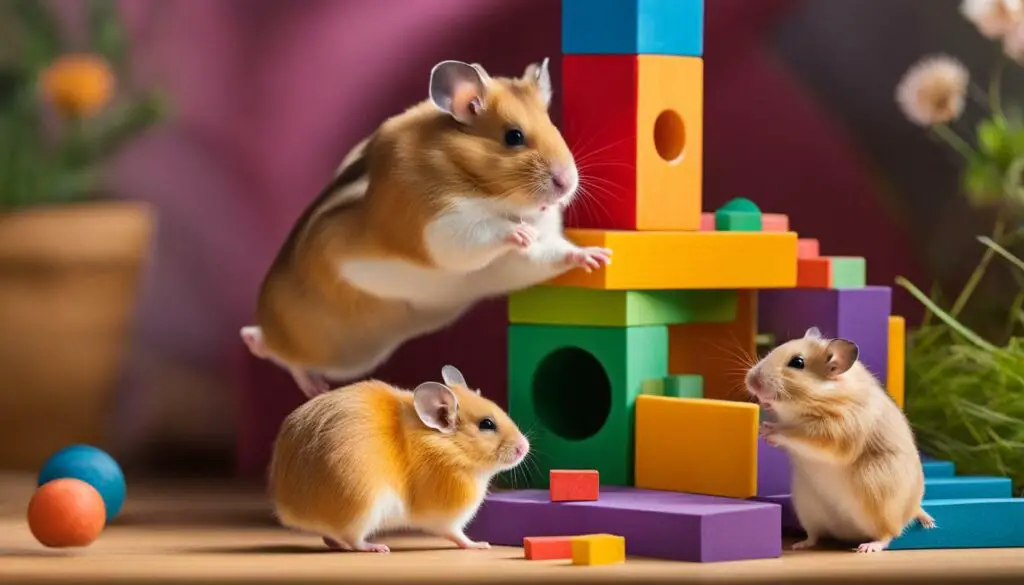
| Playful Activities | Description |
|---|---|
| Chasing | Hamsters love to run after each other, adding excitement to their playtime. |
| Grooming | Hamsters take turns cleaning each other’s fur, strengthening their bond. |
| Foraging | Searching for hidden food in their habitat stimulates hamsters’ instinct to forage and provides mental stimulation. |
These playful activities not only bring joy to hamsters but also contribute to their overall well-being. Whether it’s chasing, grooming, or foraging, these interactions are essential for their social development and happiness. However, it is important to monitor their playtime and ensure that it remains playful and not aggressive.
Factors Affecting Hamster Interactions
While hamsters are generally social animals, certain factors can affect their interactions with each other. One of the main factors is stress. Hamsters that are subjected to high levels of stress may become agitated and exhibit aggressive behavior towards their cage mates. This can lead to fighting and potential injuries. It is important to minimize stress in the hamster’s environment by providing a calm and enriching space.
Lack of space can also impact hamster interactions. When hamsters are given limited space to roam and explore, they may become territorial and display aggressive behavior towards other hamsters. Providing a spacious enclosure with plenty of hiding spots and tunnels can help alleviate this issue and encourage more harmonious interactions.
Another factor that can affect hamster interactions is a shortage of enrichment accessories. Hamsters need mental stimulation and activities to keep them engaged. When there are limited toys, wheels, and tunnels available, hamsters may become bored and restless, leading to increased aggression during playtime. It is essential to provide a variety of enrichment options to keep hamsters entertained and prevent conflicts.
| Factors Affecting Hamster Interactions | Description |
|---|---|
| Stress | High levels of stress can lead to aggression and fighting among hamsters. |
| Lack of Space | Limited space can cause hamsters to become territorial and display aggressive behavior. |
| Shortage of Enrichment Accessories | A lack of toys and mental stimulation can result in boredom and increased aggression. |
It is important to carefully monitor hamster interactions and separate them if necessary to prevent injury or harm. By observing their behavior and understanding the factors that can affect their interactions, you can create a safer and more enjoyable environment for your hamsters.
Remember, each hamster has its own unique personality, and some may be more prone to aggression and territorial behavior than others. Always introduce hamsters slowly and provide a gradual acclimation period to allow them to become familiar with each other’s scents and presence. If conflicts arise, it may be necessary to separate the hamsters and provide individual housing.
By taking these factors into consideration and providing a stress-free environment with ample space and enrichment, you can promote positive interactions and ensure the well-being of your hamsters.
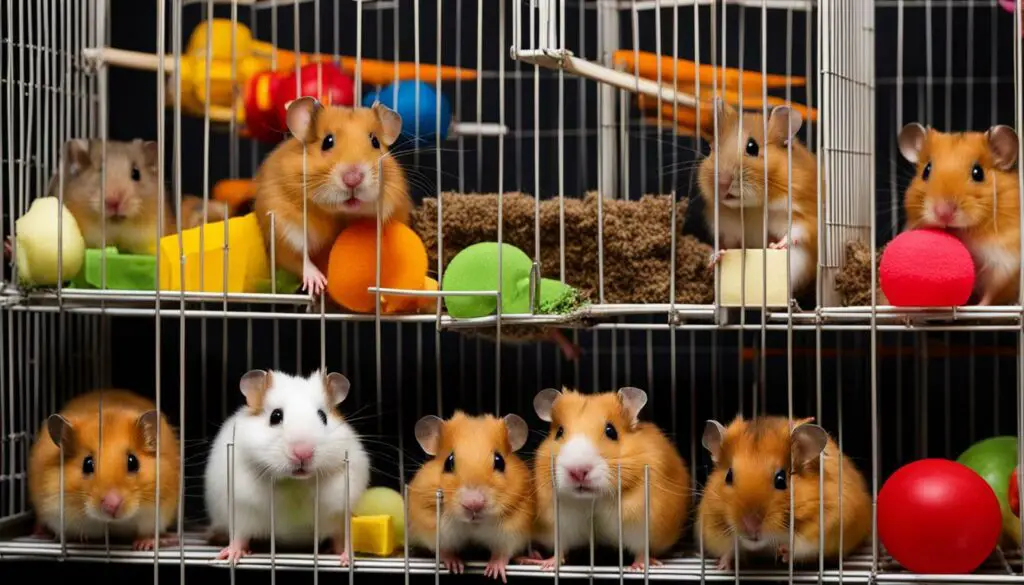
- Stress can lead to aggression and fighting among hamsters.
- Lack of space can cause hamsters to become territorial and display aggressive behavior.
- Shortage of enrichment accessories can result in boredom and increased aggression.
By monitoring interactions, providing suitable environments, and separating hamsters if necessary, you can create a safe and harmonious living space for your furry friends.
Territorial Hamsters
Not all hamsters are naturally inclined to play with each other, as some can be quite territorial. Territorial behavior is common among hamsters, and it can often lead to conflicts if they are housed together. When attempting to introduce two hamsters, it is crucial to observe their interactions closely and ensure their safety.
Hamsters that exhibit territorial behavior may display aggression towards each other, including biting, cornering, and causing injury. To avoid potential harm, it is recommended to provide separate living spaces for territorial hamsters. This will allow them to establish their own territory and minimize conflicts.
Factors like stress, lack of space, and shortage of enrichment accessories can contribute to hamsters becoming more territorial. Providing ample space and enrichment items for each hamster can help reduce stress and promote their overall well-being.
In some cases, despite efforts to create a harmonious environment, hamsters may still not bond with each other. It is essential to respect their individual needs and ensure their safety and happiness. Remember, not all hamsters are meant to be playmates.
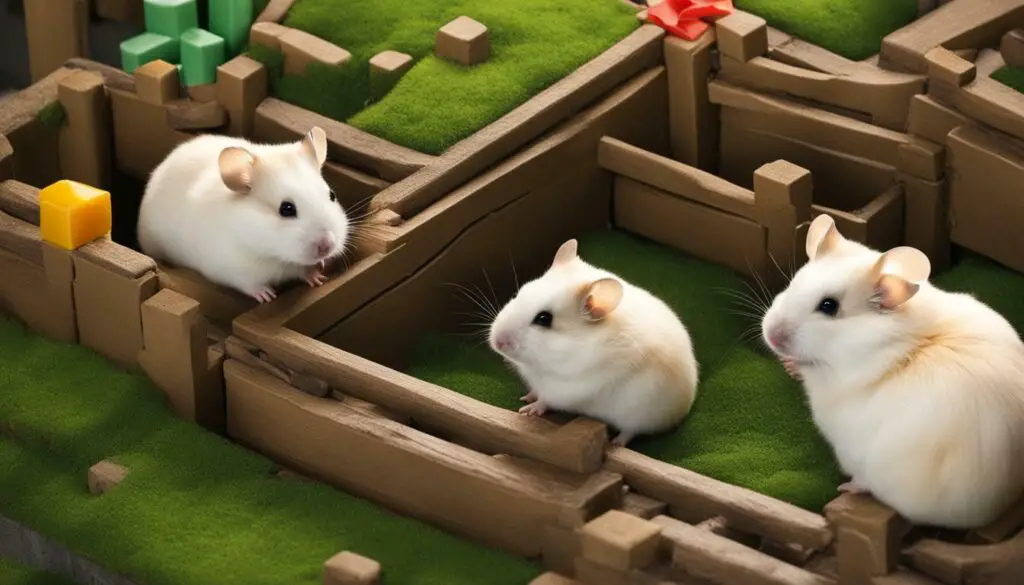
Creating a suitable environment for your hamsters is crucial for their happiness and well-being. By understanding their territorial nature and taking appropriate measures, you can ensure that your hamsters live comfortably and without unnecessary stress or conflicts.
Male and Female Hamster Interactions
Male and female hamsters may engage in interactions that are influenced by their natural instincts and the competition for mates. These interactions can range from friendly and playful to aggressive and territorial. Understanding their behavior is essential for creating a harmonious environment for your hamsters.
During the mating season, both male and female hamsters become more active and may display signs of aggression towards each other. This aggression is a result of the competition for mates. It is important to closely observe their interactions and ensure that it does not escalate into actual fighting, which can cause harm.
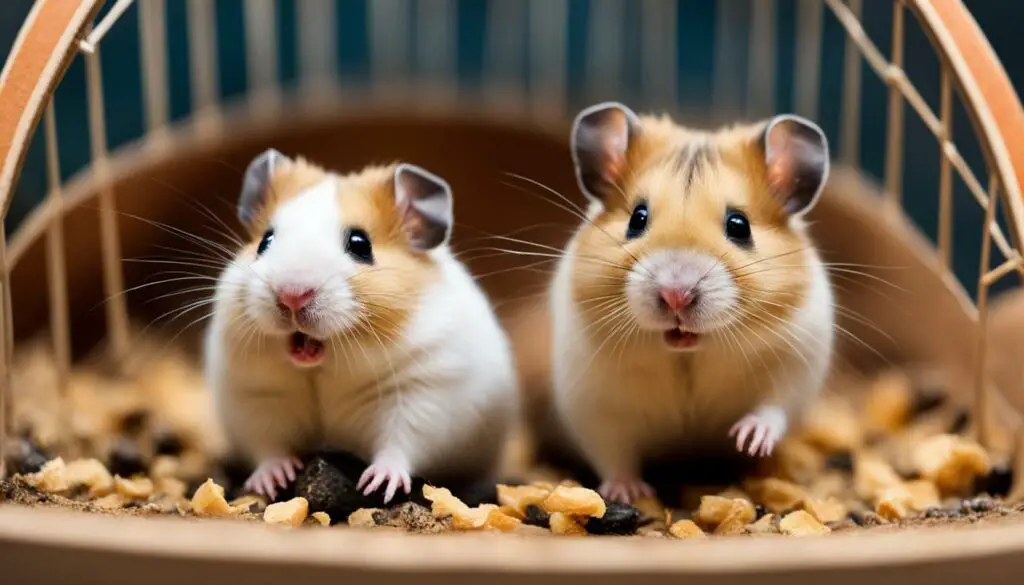
When introducing male and female hamsters for breeding purposes, it is crucial to provide them with separate cages to prevent fighting and potential injuries. Only allow supervised interactions during breeding, as males can become aggressive towards females after mating.
Suggested Activities for Male and Female Hamsters
- Provide separate playtime sessions for males and females to reduce the competition for attention and resources.
- Offer plenty of enrichment activities, such as tunnels, wheels, and chew toys, to keep them mentally stimulated.
- Ensure each hamster has its own space within their enclosure to retreat to when needed.
“Proximity does not equal compatibility. While some male and female hamsters may get along well, others may not. It’s important to assess their behavior and separate them if necessary to prevent any harm.”
| Signs of Friendly Interactions | Signs of Aggressive Interactions |
|---|---|
| – Grooming each other | – Biting |
| – Sleeping together | – Cornering |
| – Playing and chasing each other | – Puffed-up fur |
Remember, not all male and female hamsters will interact positively with each other, especially if they are not intended for breeding purposes. Always prioritize their safety and well-being by closely monitoring their interactions and providing separate spaces when necessary.
Monitoring and Separating Hamsters
When observing hamsters playing together, it’s crucial to monitor their interactions and intervene if necessary. While it’s generally natural for hamsters to engage in play fighting, it’s important to differentiate between play fighting and actual fighting. Play fighting is characterized by behaviors such as chasing, squeaking, and dominant and submissive postures, while actual fighting involves biting, cornering, and causing injury. By carefully observing their behavior, you can determine whether their interactions are playful or aggressive.
If you notice that the hamsters’ play is escalating into actual fighting, it’s necessary to separate them to prevent any harm. Fighting can lead to serious injuries, and it’s important to prioritize the safety and well-being of your hamsters. Provide each hamster with their own separate enclosure where they can live comfortably without the risk of aggression from other hamsters. Separating them will ensure that they can lead happy and stress-free lives.
In some cases, certain factors can contribute to aggression between hamsters. Stress, lack of space, and shortage of enrichment accessories can increase the likelihood of fights. It’s important to create a suitable environment for your hamsters, ensuring that they have enough space, enrichment, and resources to satisfy their social and play needs. By addressing these factors, you can help reduce the chances of aggression and create a harmonious living environment for your hamsters.
Monitoring and Separating Hamsters Table
| Factors to Monitor | Recommended Actions |
|---|---|
| Playful behaviors: chasing, squeaking, grooming, foraging | No action needed, these are normal play activities |
| Aggressive behaviors: biting, cornering, causing injury | Separate hamsters to prevent harm |
| Stress, lack of space, shortage of enrichment accessories | Address these factors to reduce aggression |
By carefully observing and monitoring your hamsters’ interactions, you can ensure their safety and well-being. Separating them if necessary and providing a suitable environment will help promote their happiness and minimize the risk of aggression. Remember to always prioritize the welfare of your hamsters and provide them with the care they need to thrive.
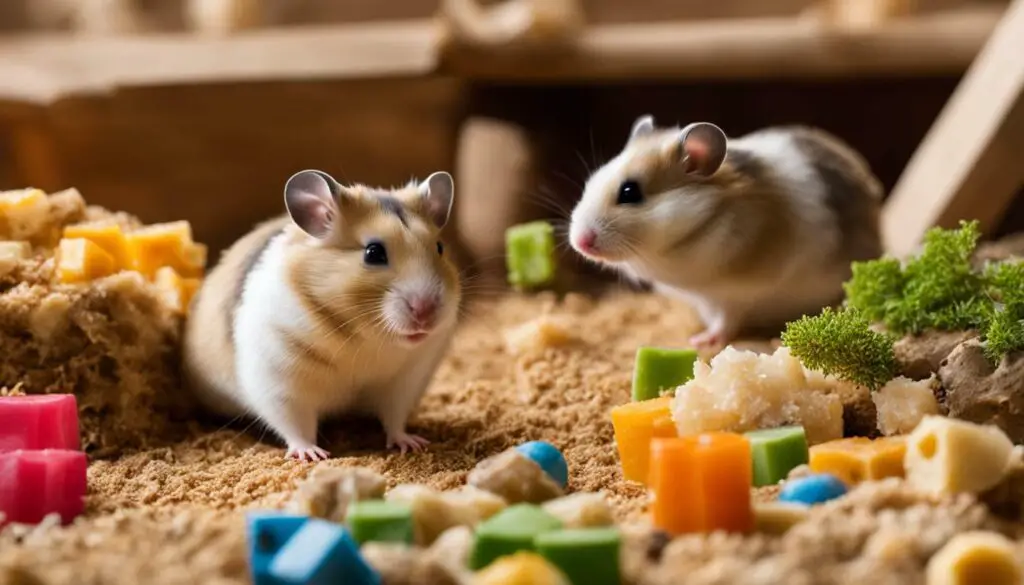
Overall, it’s important to understand that while hamsters can play with each other, it’s crucial to monitor their interactions, differentiate between play fighting and actual fighting, and intervene if necessary. By creating a suitable environment, addressing potential stress factors, and separating hamsters if needed, you can promote positive play experiences and ensure the well-being of your furry friends.
While hamsters can play with each other, it’s also important to ensure that single hamsters have ample playtime and stimulation. Playtime is crucial for their physical and mental well-being, providing them with exercise, enrichment, and social interaction.
When it comes to playtime, there are various activities you can offer your single hamster to keep them entertained. One fun option is providing them with interactive toys, such as puzzle feeders or treat balls, which stimulate their natural foraging instincts. These toys challenge them mentally and physically, keeping them engaged and mentally sharp.
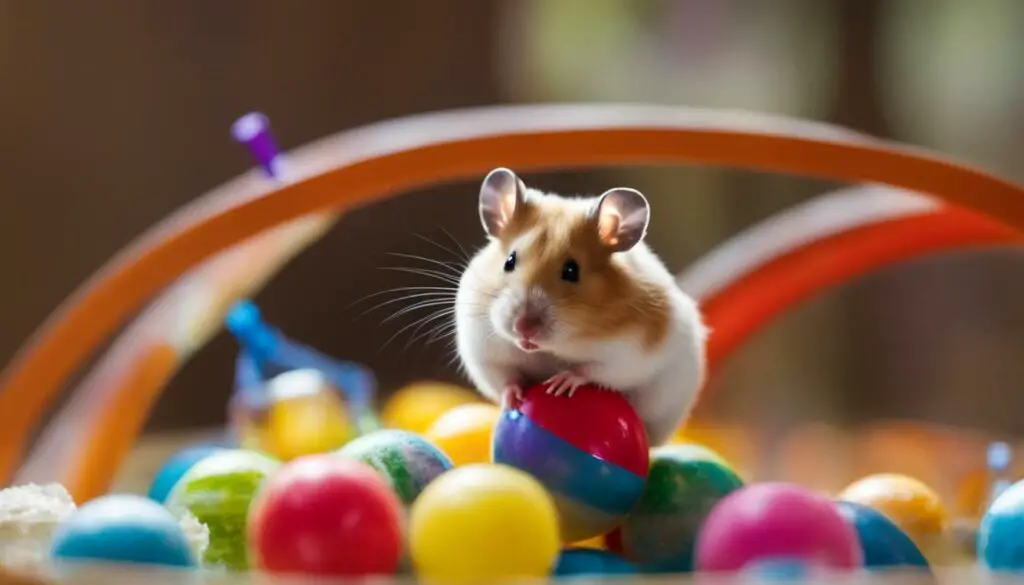
Another great way to provide playtime for your single hamster is by creating a safe and stimulating play area. Use tunnels, platforms, and climbing structures to encourage exploration and exercise. You can also scatter food or treats around the play area, allowing your hamster to forage and hunt for their food, which mimics their natural behavior.
Playtime Ideas for Single Hamsters:
- Provide interactive toys, such as puzzle feeders or treat balls
- Create a safe and stimulating play area with tunnels and climbing structures
- Scatter food or treats for your hamster to forage and hunt
- Rotate toys and activities to keep playtime interesting and engaging
- Offer different types of bedding material to encourage digging and burrowing
Remember, playtime should always be supervised, and you should provide your hamster with a safe and controlled environment. Additionally, ensure that they have a comfortable and enriched living space in their enclosure, with plenty of hiding spots, bedding material, and chew toys to keep them mentally and physically stimulated.
| Benefits of Playtime for Single Hamsters: |
|---|
| Physical exercise |
| Mental stimulation |
| Enrichment and foraging opportunities |
| Prevention of boredom and destructive behavior |
| Promotion of a healthy and happy hamster |
Providing Enrichment for Hamsters
To encourage play and social interactions among hamsters, it’s crucial to provide them with a diverse range of enrichment accessories. These accessories not only keep your furry friends entertained but also help stimulate their natural instincts. The right mix of toys, tunnels, and hiding spots can create an interactive and engaging environment for your hamsters to explore.
One popular accessory for hamsters is a hamster wheel. This allows them to exercise and burn off excess energy. Additionally, chew toys are essential for hamsters to keep their teeth in check. Opt for safe and durable materials like untreated wood or hard plastic. Providing a variety of textures and shapes will keep them engaged and prevent boredom.
| Enrichment Accessories | Description |
|---|---|
| Tunnels and Hideouts | These provide a sense of security and serve as a cozy retreat for hamsters. Select tunnels and hideouts with different entry points and textures to add variety. |
| Interactive Toys | Hamsters are curious creatures that enjoy exploring and foraging. Interactive toys such as puzzle feeders challenge their problem-solving skills and stimulate their minds. |
| Hamster Balls | Hamster balls allow for supervised free-roaming outside the cage, providing exercise and mental stimulation. Ensure the ball is appropriately sized for your hamster to avoid injury. |
“Enrichment is crucial for the overall well-being of hamsters,” says Dr. Emily Wilson, a veterinarian specializing in small mammals.
“Providing a stimulating environment with a variety of enrichment accessories can help prevent behavioral issues and promote a healthier, happier hamster.”
Remember to rotate and introduce new toys regularly to keep the environment fresh and exciting for your hamsters. It’s important to note that while providing enrichment is essential, it’s equally important to monitor your hamsters’ interactions to ensure their safety and well-being.

Conclusion
Understanding hamster play behavior and promoting positive interactions is crucial for the well-being of these adorable pets. Hamsters can indeed play with each other, engaging in activities like chasing, squeaking, grooming, and foraging. However, it is important to differentiate between play fighting and actual fighting. Play fighting involves dominant and submissive behavior, while actual fighting can result in biting, cornering, and injury.
Some hamsters may be more territorial and unable to live together peacefully. Factors such as stress, lack of space, and a shortage of enrichment accessories can also contribute to fighting among hamsters. Male and female hamsters may fight due to competition for mates.
It is essential to carefully monitor hamsters’ interactions and separate them if necessary to prevent injury or harm. Creating a harmonious environment for hamsters requires proactive observation and providing ample enrichment to support their play and socialization. Additionally, single hamsters can benefit from playtime and enrichment activities to keep them mentally stimulated and happy.
By understanding the complexities of hamster play behavior and addressing potential conflicts, we can ensure the well-being and happiness of our furry little friends. So, let’s create a playful and enriching environment for our hamsters and promote positive interactions among these delightful pets!
FAQ
Can hamsters play with each other?
Yes, hamsters can play with each other. However, it is important to distinguish between play fighting and actual fighting to ensure their safety.
How can I differentiate between play fighting and actual fighting in hamsters?
Play fighting is characterized by chasing, squeaking, and dominant and submissive behavior. Actual fighting involves biting, cornering, and causing injury. Observing their behavior can help you identify the difference.
What kind of activities do hamsters engage in when they play together?
Hamsters that play together may sleep together and engage in activities like grooming and foraging. They enjoy chasing each other and squeaking during playtime as well.
What factors can affect hamster interactions?
Factors like stress, lack of space, and shortage of enrichment accessories can affect hamster interactions. It is important to provide a comfortable and enriching environment for them to play together.
Are male and female hamsters more likely to fight?
Male and female hamsters may fight due to competition for mates. It is important to monitor their interactions closely and separate them if necessary to prevent injury.
When should I monitor and separate hamsters?
It is important to monitor hamsters’ interactions and separate them if you observe aggressive behavior, biting, or any signs of distress. This is crucial to prevent injury or harm.
Do hamsters need playmates?
While hamsters can enjoy playtime with each other, some hamsters are more territorial and may not be able to live together peacefully. Single hamsters can still have a fulfilling playtime with proper enrichment in their environment.
How can I provide enrichment for hamsters?
Providing enrichment accessories like tunnels, hideouts, and toys can keep hamsters engaged and stimulated during playtime. It is important to create a stimulating environment for their overall well-being.




